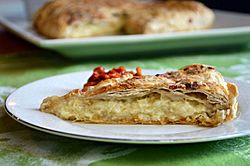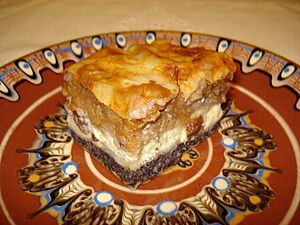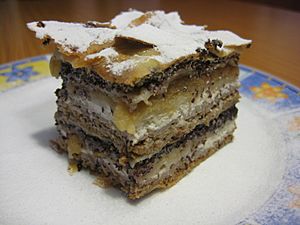Gibanica facts for kids

A piece of Gibanica.
|
|
| Alternative names | Gužvara |
|---|---|
| Type | Pastry |
| Place of origin | former Yugoslavia |
| Serving temperature | Hot or cold |
| Main ingredients | Phyllo dough, white cheese (feta, sirene), eggs |
| Other information | Other ingredients include milk, kaymak and lard or sunflower oil and different types of fruit and nuts |
Gibanica (Serbian Cyrillic: Гибаница) is a delicious pastry from the Balkans. It's usually made with cheese and eggs. You can find both sweet and savory versions. Some are simple, while others are fancy, with many layers!
The name Gibanica comes from the Serbo-Croatian word gibati. This word means "to fold" or "to sway." The pastry was first written about in a Serbian dictionary in 1818. A Slovenian priest also described it in 1828. He said it was a special Slovenian cake. It was a must-have at weddings and served to workers after big projects.
Gibanica is a type of layered pastry, similar to a strudel. It shows influences from Turkish and Austrian cooking. Today, you can find different versions of this cake in many countries. These include Slovenia, Croatia, Serbia, Bosnia, Hungary, Bulgaria, North Macedonia, Greece, Turkey, and Syria.
Sometimes, "Gibanica" can also mean a nut roll. This is a sweet bread with a spiral of walnut paste baked inside.
Contents
What's in a Name?
The word gibanica comes from the Serbo-Croatian verb gíbati. This means "to fold" or "to sway." There are also related words. For example, gibaničar means someone who makes or loves to eat gibanica. It can also mean someone who always shows up as a guest to eat it for free!
Some people think the word gibanica might come from the Egyptian Arabic word gebna. This word means a soft, salty white cheese. This type of cheese is often used to make gibanica.
How Gibanica is Made
The original way to make Gibanica used homemade phyllo dough. It also used cheese from cow's milk. The homemade cheese could be feta or sirene.
The pie is often made as gužvara, which means "crumpled pie." This is because the phyllo dough in the middle is crumpled and filled. Besides cheese, the filling usually has eggs, milk, kaymak, lard, salt, and water.
Sometimes, other ingredients are added to the filling. These can include spinach, meat, nettle, potato, and onion. To make it faster, people can use store-bought phyllo dough. They might also use sunflower oil or olive oil instead of lard.
Different Kinds of Gibanica
You can find many types of Gibanica and similar dishes across the Balkans. Different gibanica are part of the national foods in Bosnia and Herzegovina, Croatia, Serbia, and Slovenia. You can also find them in Friuli-Venezia Giulia (Italy), Greece, North Macedonia, and Bulgaria. In Bulgaria, it's often called Banitsa.
Recipes can be sweet or savory. They can be simple or very fancy, with many layers. After World War II, a richer, greasier version became known as "Chetnik Gibanica."
Many local versions have developed from the basic recipe.
-
Prekmurska gibanica, a Slovenian version.
-
 Međimurska gibanica, a Croatian version.
Međimurska gibanica, a Croatian version. - Prekmurska gibanica is a special multi-layered cake from Prekmurje in Slovenia. It's served as a dessert on special days.
- Međimurska gibanica is from the nearby Međimurje region in Croatia. It's similar but simpler. It has four layers of fillings: fresh cheese (quark), poppy seeds, apple, and walnuts.
- Another type, called Prleška gibanica, is from Prlekija, west of the Mur River.
The main idea of Gibanica is a cake or pie with layers of pastry and cheese. Often, other fillings are added too. This idea is common in the cooking of the Balkans, Anatolia, and the Eastern Mediterranean. For example, a similar dish called Shabiyat is eaten in Syria and Lebanon. Gibanica is also like a cheese strudel. They probably share a common history from the Byzantine and Ottoman empires.
Gibanica in Culture
Gibanica is one of the most popular and well-known pastries from the Balkans. People enjoy it on special occasions or as a comforting family snack. In Serbia, it's eaten for breakfast, dinner, as an appetizer, or just a snack. It's also often part of traditional events like Christmas, Easter, and Slava.
The biggest Gibanica ever made was in Mionica in 2007. It weighed over 1,000 kg (about 2,200 pounds)! They even tried to get it into the Guinness Book of Records. To make it, they used:
- 330 kg of phyllo dough
- 330 kg of cheese
- 3,300 eggs
- 30 liters of oil
- 110 liters of mineral water
- 50 kg of lard
- 500 packets of baking powder
There are even festivals just for gibanica!
- The Gibanica festival, or Days of Banitsa, happens every year in Bela Palanka. It started in 2005.
- Slovenia has a festival for Prekmurska gibanica and ham in the Prekmurje region.
- Croatia has a gibanica festival in Igrišće in Hrvatsko Zagorje.
See also
 In Spanish: Gibanica para niños
In Spanish: Gibanica para niños


